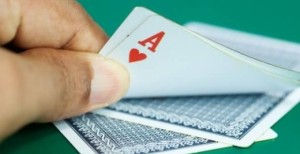If you’re an experienced Texas Hold’em player, you won’t need long to learn one of its variations: Omaha Hi. These two games are very similar so, once you master the differences, you’ll be well on your way to becoming a good, if not great, Omaha player.
Even if you’re new to poker in general, learning Omaha is fairly easy. Keep reading this guide to learn how to play one of the poker room’s most popular card games.
In Omaha, your goal is to create the best five-card hand from a total of nine cards: four in your hand and five community cards. The catch is that, unlike Hold’em, Omaha requires you to use exactly two of your hole cards. This means that you will take three of the five community cards to make your hand – and hope that what you end up holding is good enough to take the pot.
 If you’re playing online or in a card room, there will be a dealer button that rotates clockwise after each hand. The two players to the left of the “dealer” must post the small blind and big blind (respectively) before the hand is dealt. Typically, the small blind is half the size of the big blind.
If you’re playing online or in a card room, there will be a dealer button that rotates clockwise after each hand. The two players to the left of the “dealer” must post the small blind and big blind (respectively) before the hand is dealt. Typically, the small blind is half the size of the big blind.
After these two players post the blinds, you’re dealt your hole cards. These are facedown, so only you know what you’re holding. Remember that you must use two of these cards to make your hand, so don’t get too excited if you’re dealt four Jacks.
Betting depends on which Omaha game you’re playing. Omaha can be fixed-, pot- or no-limit. Fixed-limit games have specific amounts for betting and raising. In pot-limit games, you can bet or raise up to the size of the pot. In no-limit Omaha, you can bet or raise every chip you have.
Omaha has four betting rounds. They come:
After your hole cards are dealt.
After the flop (first three community cards) are dealt.
After the turn (fourth community card) is dealt.
After the river (fifth community card) is dealt.
The standard hand rankings apply in Omaha. A set (three of a kind) beats two pairs, for example, and a full house (a set and a pair) beats a straight.
If you’re still in the hand after the final betting round, you’ll show down your hand to win the pot. You do, however, need to be careful when you’re reading your hand. Because you’re dealt four hole cards, but must use two, it’s easy to make mistakes. Here are some examples of common mistakes in Omaha.
Your hole cards:
A-A-3-4
The board cards:
K-Q-8-3-3
You might think that you have a full house – two Aces and a set of threes – but you don’t. Because you can use only two of your hole cards, you would take an Ace and the three from your hand to make a set of threes with the best-possible kicker, the Ace.
Your hole cards:
A-K-Q-J
The board cards:
Q-T-9-4-2
This might appear to be an Ace-high straight, but that is incorrect. To make an Ace-to-ten straight, you would have to use the Ace, King and Jack in your hand. This is not possible in Omaha.
However, you do have a King-high straight. Use the King and Jack from your hand and the Queen, ten and nine from the board to make this hand.
Because the extra two hole cards create more possible hands, you have to be careful with smaller hands. Two pairs might be a great hand in Hold’em, but they’re not quite as good in Omaha. You’re more likely to see sets and full houses, along with flushes, in Omaha because of the added combinations that the four hole cards make.
Your basic Hold’em skills will help you in Omaha, but keep the big difference – those extra cards – in mind. This is easy to remember once you’ve played the game for a while, though, so don’t let yourself become frustrated if you can’t keep things straight at first.
Once you’ve mastered the basics of Omaha, you can start working on some advanced skills. These will help you collect more chips over the long term, which is always a plus as far as serious poker players are concerned. Learning how to read the board, put other players on specific hands and read their tells all make you a better player – regardless of which poker game you’re playing.